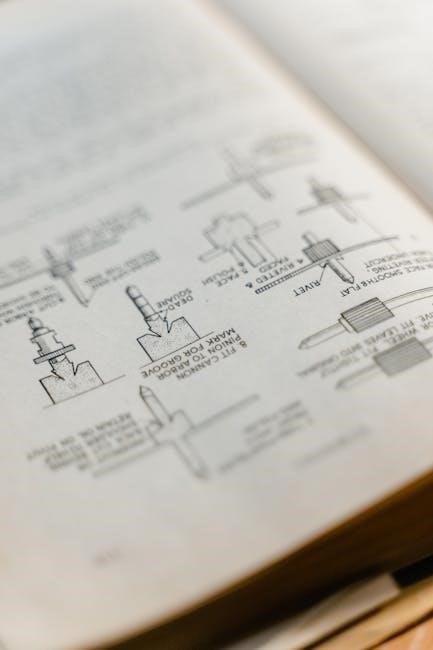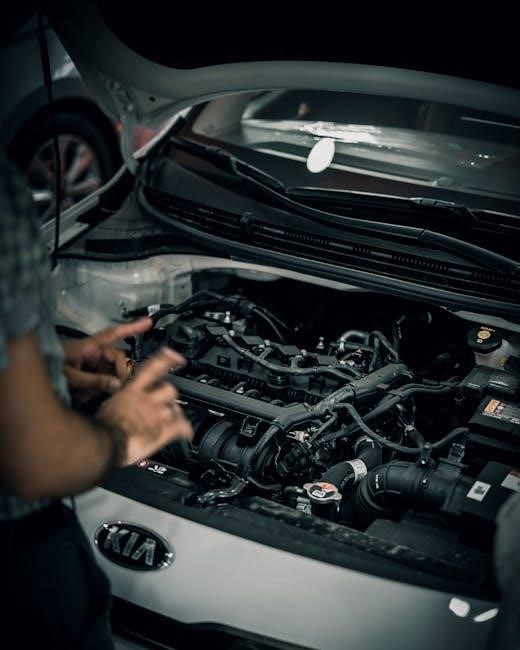noco gbx45 manual
Welcome to the NOCO GBX45 manual, your comprehensive guide to understanding and using this advanced jump starter. This device is designed to safely and effectively jump-start vehicles, offering powerful features like USB-C Power Delivery and LED indicators. The manual ensures optimal performance and safety, covering everything from charging to troubleshooting. Read carefully to maximize your experience with the GBX45.
1.1 Overview of the NOCO GBX45 Device
The NOCO GBX45 is a portable lithium jump starter designed for reliable performance in various situations. It features USB-C Power Delivery, LED indicators for status monitoring, and advanced safety protections. With a 1250-amp capacity, it can jump-start cars, trucks, boats, and more. The device also serves as a powerful power bank, capable of charging smartphones and other electronics. Its compact design and user-friendly interface make it an essential tool for emergencies and everyday use, ensuring convenience and efficiency on the go.
1.2 Importance of the Manual for Safe and Effective Use
The NOCO GBX45 manual is essential for ensuring safe and effective operation of the device. It provides critical safety precautions, such as avoiding electrical shock and proper handling techniques, to prevent accidents. The manual also guides users through the device’s features, charging methods, and troubleshooting steps. By following the instructions, users can maximize the device’s performance, avoid potential hazards, and extend its lifespan. Reading and understanding the manual is crucial for a safe and optimal experience with the GBX45.

Safety Information and Precautions
This section outlines crucial safety guidelines for the NOCO GBX45, including warnings against electrical shock, sparks, and improper handling. Always follow safety precautions to avoid accidents.
2.1 General Safety Guidelines
Always follow safety guidelines when using the NOCO GBX45. Avoid sparks, open flames, or smoking near the device. Ensure the area is well-ventilated and free from flammable materials. Never modify the device or use damaged cables. Keep the GBX45 away from children and pets. Properly connect clamps to avoid short circuits. Use the device only for its intended purpose and follow all warnings to prevent injury or damage. Safe handling ensures reliable performance and longevity of the product.
2.2 Electrical Safety and Handling Precautions
Prevent electrical shock by avoiding contact with live circuits. Never disassemble the GBX45, as internal components can cause injury. Keep the device away from water and moisture. Use only approved chargers and cables to prevent damage. Avoid overcharging, as it may lead to battery degradation. Always follow the manufacturer’s charging instructions. Ensure proper ventilation during charging to prevent overheating. Handling the device with care reduces the risk of electrical hazards and ensures safe, reliable operation.
2.3 Warning Signs and Emergency Procedures
Be alert to warning signs such as unusual odors, excessive heat, or loud noises, which may indicate a malfunction. If the device overheats or emits smoke, immediately disconnect it and move to a well-ventilated area. In case of physical damage or exposure to liquids, stop use and contact NOCO support. For emergency situations, avoid sparks or open flames near the device. Keep it away from children and pets to prevent accidental harm. Always prioritize caution to ensure safe operation and prevent potential hazards.
Key Features of the NOCO GBX45

The NOCO GBX45 is a 1250-amp portable lithium jump starter with USB-C Power Delivery, LED indicators, and versatile charging capabilities for cars, boats, and trucks.

3.1 Technical Specifications and Capabilities
The NOCO GBX45 is a 1250-amp portable lithium jump starter, designed for jump-starting cars, boats, and trucks. It features USB-C Power Delivery, providing up to 60-watts for charging devices. The device includes LED indicators for status monitoring and offers multiple safety protections. With its compact design and advanced technology, the GBX45 delivers reliable performance for various applications, making it a versatile tool for emergency power needs on the go.
3.2 USB-C Power Delivery and Charging Options
The NOCO GBX45 features USB-C Power Delivery 3.0, delivering up to 60-watts of power for fast charging. This capability allows you to charge smartphones, tablets, and laptops efficiently. The USB-C port supports both input and output, making it versatile for powering devices. With its high-speed charging, the GBX45 is not only a jump starter but also a reliable power bank for everyday use, ensuring your devices stay charged on the go or in emergencies.
3.3 LED Indicators and Modes
The NOCO GBX45 features LED indicators that provide clear status updates. The LED flashes white when Manual Override is active, ensuring safe operation. A blue LED indicates system status and charging progress, while red signals errors or malfunctions. Additionally, the LED displays a steady green light when the battery is fully charged. These indicators, along with an SOS mode for emergencies, help users stay informed and in control of their device’s functions and battery status at all times.

Charging the NOCO GBX45
The GBX45 is best charged using the NOCO Auto Charger, ensuring fast and efficient power replenishment. Connect the charger to a power source and the device, with the vehicle turned on for optimal charging. Avoid extreme temperatures or flammable environments during charging to maintain safety and device longevity. Always follow the manual’s guidelines for proper charging procedures;

4.1 Recommended Charging Methods
The NOCO GBX45 is best charged using the NOCO Auto Charger, which provides fast and efficient power replenishment. For optimal charging, ensure the vehicle is turned on and in the “on” or “accessory” mode. Avoid charging in extreme temperatures or flammable environments. The Auto Charger is designed to safelycharge the GBX45’s internal battery, ensuring it is ready for jump-starting or power delivery when needed. Always follow the manual’s guidelines for proper charging procedures to maintain device performance and longevity.

4.2 Using the NOCO Auto Charger
The NOCO Auto Charger is the primary recommended method for charging the GBX45. Connect the charger to the device’s charging port and ensure the vehicle is in the “on” or “accessory” mode. The LED indicator will illuminate, showing the charging progress. Fast charging begins automatically when the vehicle’s system detects the connection. Always monitor the charging process and avoid interrupting it to ensure a full and stable charge. This method guarantees optimal battery health and performance for the GBX45.
4.3 Fast Charging and Power Delivery Activation

Fast charging on the NOCO GBX45 is activated when the device is connected to a vehicle with the ignition in the “on” position. The LED indicator will flash rapidly, signaling fast charging mode. USB-C Power Delivery 3.0 is enabled automatically, providing up to 60 watts of power for charging external devices. Ensure the device is powered off after reaching full charge to maintain battery health. Always follow safety guidelines to avoid overcharging or electrical issues. Proper activation ensures efficient and safe charging for both the GBX45 and connected devices.

Using the NOCO GBX45 for Jump Starting
The NOCO GBX45 simplifies jump starting with its advanced features. Connect the clamps to the battery, start the vehicle within 60 seconds, and power off the device afterward for safe operation and optimal performance.
5.1 Step-by-Step Jump Starting Instructions
- Ensure the GBX45 is fully charged and free from damage.
- Connect the positive (red) clamp to the dead battery’s positive terminal.
- Attach the negative (black) clamp to a grounded metal surface or the negative terminal.
- Press the power button to activate the device.
- Start the vehicle within 60 seconds of activation.
- Once the engine runs, turn off the GBX45 and remove the clamps in reverse order.
Always follow safety guidelines to avoid electrical shock or damage.
5.2 Manual Override Feature and Usage
The Manual Override feature allows starting vehicles with high battery resistance or non-standard systems. Activate it by holding the power button for 3 seconds until the LED flashes white. Ensure the device is connected correctly and the vehicle’s ignition is on. Use this mode cautiously, as it bypasses automatic safety checks. The LED will remain white during override. Only use Manual Override if the device doesn’t detect a battery. Always consult the manual for specific instructions to avoid risks.
5.3 Post-Jump Starting Procedures
After successfully jump-starting, disconnect the GBX45 immediately. Turn off the device and remove the clamps from the battery terminals. Start the vehicle’s engine and let it run for a few minutes to recharge the battery. The GBX45 will automatically shut down after 60 seconds if no load is detected. Check the LED indicator for battery level status. If necessary, recharge the device using the recommended charger. Store the GBX45 in a cool, dry place to maintain performance. Always refer to the manual for detailed care instructions.

Troubleshooting Common Issues
Identify and resolve issues with the GBX45 by checking LED indicators, battery levels, and connections. Restart the device or reset it if necessary. Consult the manual for detailed solutions to common problems like activation issues or charging errors. Ensure proper usage and maintenance for optimal performance.
6.1 Diagnosing Battery and Connection Problems
To diagnose battery and connection issues, start by checking the LED indicators on the GBX45. A flashing red light may indicate a low battery, while a solid red light signals a charging error. Ensure all cables are securely connected and free from damage. If the device fails to power on, verify the internal battery level and charge it using the recommended Auto Charger. Consult the manual for detailed diagnostic steps to address specific problems effectively.
6.2 Resolving LED Flashing or Activation Issues
If the LED on your GBX45 is flashing or not activating, check the battery level and ensure proper connections. A white flashing LED indicates manual override mode, while red flashes may signal errors. Restart the device by turning it off and on. If issues persist, reset the GBX45 by holding the power button for 10 seconds. Consult the manual for specific LED patterns and their meanings to address the problem effectively and restore normal functionality.
6.3 Resetting the Device
To reset the NOCO GBX45, press and hold the power button for 10 seconds until the LED turns off. Release the button and wait for the device to restart. This process resets all settings to factory defaults but does not erase saved preferences. Ensure the device is fully charged before performing a reset. If issues persist after resetting, contact NOCO customer support for further assistance. Resetting is a useful troubleshooting step for resolving persistent operational issues.
Warranty and Support Information
NOCO warrants the GBX45 against manufacturing defects for a specified period. For inquiries or claims, contact NOCO customer support via their official website or provided contact details.
7.1 Warranty Terms and Conditions
The NOCO GBX45 is covered under a limited warranty that protects against manufacturing defects. The warranty period begins from the date of purchase and varies based on product registration. Coverage includes repairs or replacements at NOCO’s discretion. Damages from misuse, neglect, or unauthorized modifications are excluded. For full details, refer to the warranty section in the manual or visit NOCO’s official website. Proper registration ensures eligibility for warranty benefits.
7.2 Contacting NOCO Customer Support
For assistance with the NOCO GBX45, visit the official NOCO website at no.co/support. Here, you can submit a support ticket, browse FAQs, or find contact information. Customer support is available to address inquiries, troubleshooting, and warranty-related issues. Representatives are trained to provide detailed assistance and ensure a positive experience. For faster service, have your product serial number and purchase details ready when reaching out. NOCO’s support team is committed to resolving issues promptly and efficiently.
8.1 Summary of Key Points
The NOCO GBX45 manual provides essential guidance for safe and effective use. Key points include following safety precautions, understanding LED indicators, and proper charging methods. The device offers powerful jump-starting capabilities, USB-C Power Delivery, and troubleshooting solutions. Always refer to the manual for detailed instructions and warranty information to ensure optimal performance and longevity of your GBX45.
8.2 Final Tips for Optimal Use
For optimal use of the NOCO GBX45, always check the battery level before jump-starting. Store the device in a cool, dry place to maintain performance. Regularly update the firmware and use original NOCO accessories for compatibility. Avoid overcharging and ensure proper connections to prevent damage. Use the manual override feature only when necessary and follow safety guidelines strictly. Keep the device clean and inspect cables for wear. By following these tips, you’ll extend the lifespan and ensure reliable operation of your GBX45;








































































